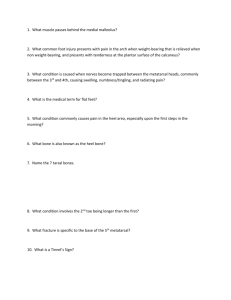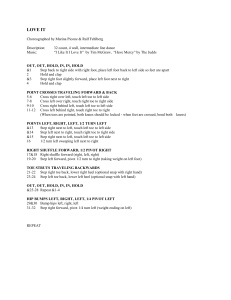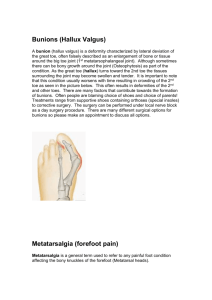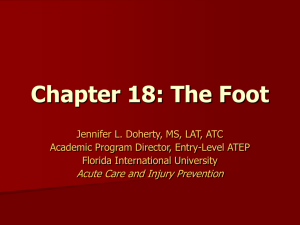Chapter 18: The Foot - Florida International University
advertisement
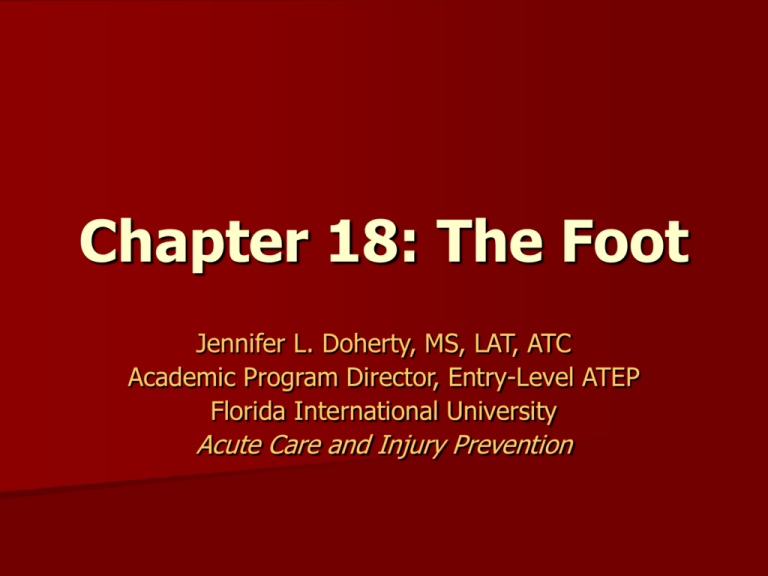
Chapter 18: The Foot Jennifer L. Doherty, MS, LAT, ATC Academic Program Director, Entry-Level ATEP Florida International University Acute Care and Injury Prevention Review of Anatomy Arches of the Foot Plantar Fascia Muscles of the Foot and Lower Leg Nerve Supply and Blood Supply Excessive Pronation Major cause of stress injuries – Overload of structures during stance phase – Prolonged pronation into propulsive phase Results in loose foot – Excessive midfoot motion – Decreased stability of first ray – Increased pressure on metatarsals – Increased tibial rotation at knee Excessive Pronation Causes weakness push off – Does not allow foot to resupinate to provide rigid lever – Less powerful, less efficient force produced Common injuries: – 2nd metatarsal stress fracture, Plantar fascitis Posterior tibialis tendinitis, Achilles tendinitis, Tibial stress syndrome, and Medial knee pain Excessive Supination Results in rigid foot – Decreased mobility of calcaneocuboid joint – Decreased mobility of first ray causing weight absorption on 1st and 5th metatarsals – Increased tension of peroneus longus – Inefficient shock absorption Common injuries: – Inversion sprains, Tibial stress syndrome, Peroneal tendinitis, IT-Band friction syndrome, and Trochanteric bursitis Foot Injuries Apophysitis of the Calcaneus (Sever’s Disease) Etiology – Traction injury at apophysis of calcaneus Where Achilles tendon attaches to calcaneous Signs and Symptoms – Pain occurs at posterior heel below Achilles attachment – Pain occurs during vigorous activity – Pain ceases following activity Foot Injuries Apophysitis of the Calcaneus (Sever’s Disease) cont. Management – Best treated with ice, rest, stretching and NSAID’s – Heel lift could also relieve some stress Foot Injuries Retrocalcaneal Bursitis (Pump Bump) Etiology – Caused by inflammation of bursa beneath Achilles tendon – Result of pressure and rubbing of shoe heel counter – Chronic condition that develops over time May take extensive time to resolve – Exostosis may also develop Signs and Symptoms – Pain with palpation superior and anterior to Achilles insertion – Swelling on both sides of the heel cord Foot Injuries Retrocalcaneal Bursitis (Pump Bump) cont. Management – – – – – – RICE and NSAID’s used as needed Ultrasound can reduce inflammation Routine stretching of Achilles Heel lifts to reduce stress Donut pad to reduce pressure Possibly invest in larger shoes with wider heel contours Metatarsal Injuries Pes Planus Foot (Flatfoot) Etiology – Excessive pronation and forefoot varus – Wearing tight shoes Weakens supportive structures with shoe – Being overweight – Excessive exercise placing undo stress on arch Signs and Symptoms – Pain, weakness, or fatigue in medial longitudinal arch – Calcaneal eversion – Bulging navicular – Flattening of medial longitudinal arch – Dorsiflexion with lateral splaying of 1st metatarsal Metatarsal Injuries Pes Planus Foot (Flatfoot) cont. Management – If no signs and symptoms – “don’t fix what isn’t broken” – If problems develop… Orthotics with a medial wedge may be used Taping of arch can also be used for additional support Metatarsal Injuries Pes Cavus (High Arches) Etiology – Excessive supination – Associated with forefoot valgus – Accentuated high medial longitudinal arch Signs and Symptoms – – – – – Poor shock absorption Metatarsalgia Foot pain Clawed or hammer toes Shortening of Achilles and plantar fascia – Heavy callus development on ball and heel of foot Metatarsal Injuries Pes Cavus (High Arches) cont. Management – If no signs and symptoms – “don’t fix what isn’t broken” – If problems develop… Orthotics with a lateral wedge may be used Stretch Achilles and plantar fascia Metatarsal Injuries Plantar Fasciitis Plantar fascia – Dense, broad band of connective tissue attaching proximal and medially on the calcaneus and fans out over the plantar aspect of the foot – Works in maintaining stability of the foot and bracing the longitudinal arch Plantar Fasciitis – “Catch all” term used for pain in proximal arch and heel – Common in athletes and nonathletes – Attributed to heel spurs, plantar fascia irritation, and bursitis Metatarsal Injuries Plantar Fasciitis cont. Etiology – Increased tension and stress on fascia Particularly during push off of running phase – Change from rigid supportive footwear to flexible footwear – Running on soft surfaces while wearing shoes with poor support – Poor running technique – Leg length discrepancy, excessive pronation, inflexible longitudinal arch, or tight gastrocsoleus complex Metatarsal Injuries Plantar Fasciitis cont. Signs and Symptoms – Pain in anterior medial heel and along medial longitudinal arch – Increased pain in morning Plantar fascia loosens after first few steps thus decreasing pain – Increased pain with forefoot dorsiflexion Metatarsal Injuries Plantar Fasciitis cont. Management – Extended treatment (8-12 weeks) – Orthotic therapy is very useful Soft orthotic with deep heel cup – – – – – Simple arch taping Night splint to stretch plantar fascia Vigorous heel cord stretching Exercises that increase great toe dorsiflexion NSAID’s and occasionally steroidal injection Metatarsal Injuries Jones Fracture Etiology – Inversion and plantar flexion – Direct force (stepped on) – Repetitive trauma – Most common fracture site is at the base of the 5th metatarsal Signs and Symptoms – Immediate swelling – Pain over 5th metatarsal – High nonunion rate – Course of healing is unpredictable Metatarsal Injuries Jones Fracture cont. Management – Controversial treatment – Crutches with no immobilization – Gradual progression to weight bearing as pain subsides May allow athlete to return in 6 weeks – If nonunion of the fracture is evident, surgery with internal fixation may be required Metatarsal Injuries Bunion (Hallux Valgus Deformity) Etiology – Exostosis of 1st metatarsal head – Associated with… Forefoot varus Wearing shoes that are too narrow or too short Wearing shoes with pointed toes – Bursa becomes inflamed and thickens Enlarges the joint and causes lateral malalignment of the great toe Bunionette (Tailor’s bunion) – Impacts 5th metatarsophalangeal joint – Causes medial displacement of 5th toe Metatarsal Injuries Bunion (Hallux Valgus Deformity) cont. Signs and Symptoms – Initially… Tenderness Swelling Enlargement of joint – As inflammation continues… Angulation of the joint increases Painful ambulation – Tendinitis in great toe flexors may develop Bunion (Hallux Valgus Deformity) cont. Management – Early recognition and care is critical – Wear correct fitting shoes – Orthotics may be used – Padding over 1st metatarsal head with a tape splint between 1st and 2nd toe may be used – Exercises for flexor and extensor muscles – Bunionectomy may be necessary Injuries to the Toes Turf Toe Etiology – Hyperextension injury – Results in sprain of 1st metatarsophalangeal joint – May be the result of single or repetitive trauma Signs and Symptoms – Pain and swelling – Both increase during… Push off in walking Running Jumping Injuries to the Toes Turf Toe cont. Management – Orthotics to increase rigidity of forefoot region within the shoe – Taping the toe to prevent dorsiflexion – Ice and ultrasound – Rest Discourage activity until pain free Injuries to the Toes Fractures and Dislocations of the Phalanges Etiology – Kicking unyielding object – Stubbing toe – Being stepped on – Dislocations are less common than fractures Signs and Symptoms – Immediate and intense pain – Obvious deformity with dislocation Injuries to the Toes Fractures and Dislocations of the Phalanges cont. Management – Dislocations should be reduced by a physician – Casting may occur with great toe or multiple toe fractures – Buddy taping is generally sufficient Injuries to the Toes Hammer Toe, Mallet Toe, or Claw Toe Etiology – Hammer toe Flexion contracture of the PIP joint, which can become fixed – Mallet toe Flexion contracture of the DIP joint, which can become fixed – Claw toe Flexion contracture of the DIP joint with hyperextension at the MP joint – All may be caused by wearing short shoes over an extended period of time Injuries to the Toes Hammer Toe, Mallet Toe, or Claw Toe cont. Signs and Symptoms – The MP, DIP, and PIP can all become fixed – Swelling – Pain – Callus formation – Occasionally infection Injuries to the Toes Hammer Toe, Mallet Toe, or Claw Toe cont. Management – Wear shoes with more room for toes – Use padding and taping to prevent irritation – Shave calluses – Once the contracture becomes fixed, surgery will be required to correct Injuries to the Toes Subungual Hematoma Etiology – Direct pressure – Dropping an object on toe – Kicking another object – Repetitive shear forces on toenail Injuries to the Toes Subungual Hematoma cont. Signs of Injury – Accumulation of blood underneath toenail – Likely to produce extreme pain – May result in loss of toe nail Management – RICE immediately Reduces pain and swelling – Relieve pressure within 12-24 hours Lance or drill nail Must be sterile to prevent infection Foot Rehabilitation General Body Conditioning A period of non-weight bearing is common, therefore alternative means of conditioning must be introduced – Pool running – Upper body ergometer General strengthening and flexibility should be included as allowed by injury Foot Rehabilitation Progression to Weight Bearing If unable to walk without a limp, crutch or cane walking should be utilized Poor gait mechanics will impact other joints within the kinetic chain – Could result in additional injuries Progress to full weight bearing as soon as tolerable Foot Rehabilitation Flexibility Must maintain or reestablish normal flexibility of the foot – Full range of motion is critical for normal function Stretching of the plantar fascia and Achilles tendon is very important Foot Rehabilitation Strengthening Writing alphabet Picking up objects Ankle circumduction Gripping and spreading toes Towel gathering Towel Scoop Foot Rehabilitation Neuromuscular Control Critical to re-establish because it is the single most important element dictating movement Muscular weakness, proprioceptive deficits, and ROM deficits challenge the athlete’s ability to maintain center of gravity without losing balance Foot Rehabilitation Neuromuscular Control cont. Must be able to adapt to changing surfaces – Involves highly integrative and dynamic process that utilizes multiple neurological pathways Proprioception and kinesthesia is essential in athletics Orthotics Use of orthotics is common practice – Used to control abnormal compensatory movement of the foot by “bringing the floor up to meet the foot” Orthotic works to place foot in neutral position, preventing compensatory motion Also works to provide platform for foot that relieves stress being placed on soft tissue, allowing for healing Foot Rehabilitation Functional Progression Athletes must engage in a functional progression to gradually regain the ability to… – Walk – Jog – Run – Change directions, and – Hop
